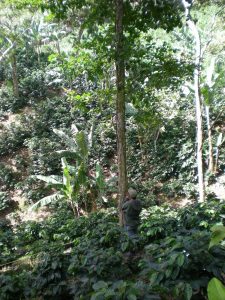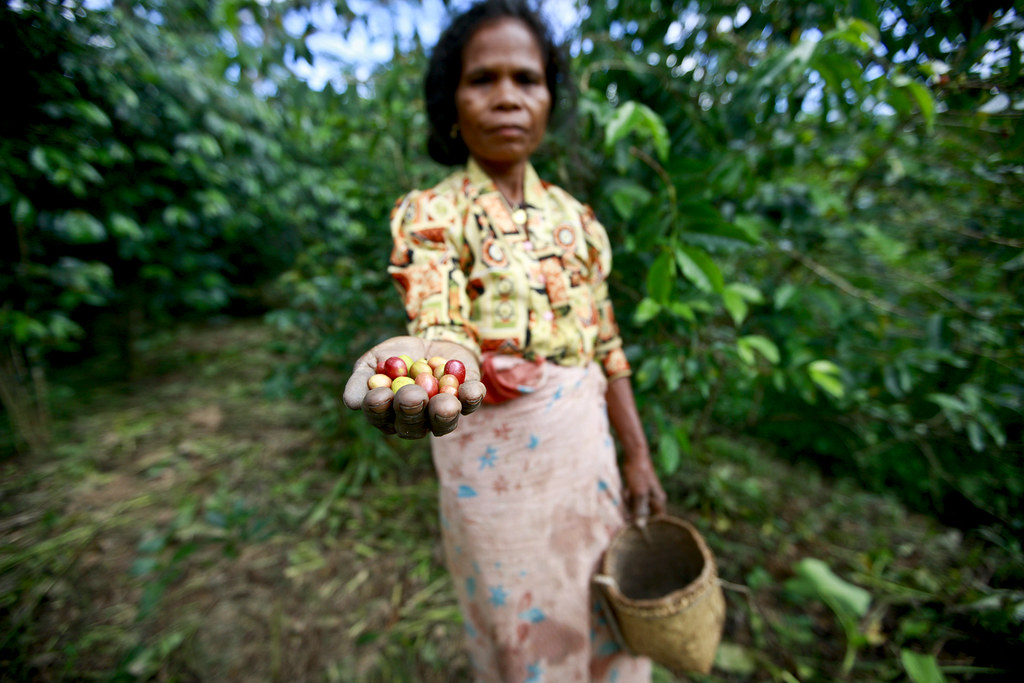“You could say this nation runs on two dark liquids — petroleum and coffee,” Professor Bob Thompson of Syracuse University once said. We’re constantly reminded of the social and environmental costs of our reliance on fossil fuels, but what about that other fuel?
Conventional coffee: value without values

Americans drink almost 40 million gallons of coffee a year, creating a $30 billion industry. Yet most of the farmers and laborers who produce the crop live in dire poverty. Big companies get big profits, while coffee producers receive just pennies on the dollar.
Conventional farming methods are hard on the environment, too. Coffee farms can displace forest and destroy crucial habitats for tropical wildlife. Chemicals used in growing and processing coffee beans contaminate local waterways. Intense cultivation makes coffee landscapes more vulnerable to diseases, hurricanes, and increasing temperatures associated with climate change. The list of problems is enough to make that morning mug taste a lot more bitter.
Grounds for Change
What can we do? Where do we start? I decided to ask someone who has built a business on answering these questions: Kelsey Marshall of Grounds for Change Coffee.

“Coffee needs to become more sustainable in order to survive the future changing climate,” says Marshall. “It is a sensitive species and will be hit hard by the projected climactic shifts.”
Marshall and his wife Stacy saw this firsthand on a trip to Costa Rica, where they spoke with laborers in coffee fields and learned about the challenges they face each season. This experience provided a spark of inspiration. Through their shared entrepreneurial spirit, they set to work in 2003 building a business that would not only create outstanding coffee, but do so in a way that honors both people and the environment. “Grounds for Change is always on the lookout for new [ways of] making the coffee supply chain more equitable and sustainable,” he explains.
Grounds for Change demands that all of their coffees be Fair Trade and Organic certified, and that’s just the start. Marshall has a seemingly endless list of goals: increasing energy efficiency, reducing waste, empowering women, building strong customer relationships, and producing exceptional coffee, just to name a few. With so many balls in the air, it seems like one would have to drop. But over the past 14 years, Grounds for Change has been juggling flawlessly. Let’s take a look at two projects that exemplify their commitment to people and to the environment.
Supporting women’s livelihoods with Cafe Femenino

Since 2004, Grounds for Change has partnered with a group of with a group of women coffee growers in Cafe Femenino. In rural Peru where these growers live, women often don’t benefit from Fair Trade programs in the way that men do. Cafe Femenino promises an even higher price for coffee beans and gives women agency over how this money is spent. Grounds for Change then gives a percentage of sales back to the women by funding grants community projects.
Strengthening communities in coffee-growing areas of Africa and Latin America as well as here at home is part of the Grounds for Change vision. “Forming long-term relationships on both ends of the coffee chain is important to Grounds for Change,” Marshall explained.
Fighting climate change by going CarbonFree

Ten years ago, Grounds for Change became the first coffee roaster in the country to be certified CarbonFree. First, they work to minimize carbon emissions through their supply chain. Through a partnership with CarbonFund.org, they plant enough trees to offset all of the carbon emissions that are left, from transportation to packaging, from roasting the beans to the heating of brewing water in customers’ homes.
This outstanding achievement clearly qualifies Grounds for Change as a leader in the field of sustainable coffee, but Marshall doesn’t take the credit. “When we first heard about CarbonFree certification for products, we said to ourselves – let’s do it!” he explained. “We enjoy being first at things, but the reality is that we did not create these movements in coffee. They are driven by customer demand for a product that has lower impact on the planet and is more equitable to those that are involved in its production. We owe our success to our discerning and loyal customers.”
A greener bean — Grounds for Change leads the way
Grounds for Change sets a strong example for new businesses hoping to making a positive impact. Still, Marshall wasn’t interested in discussing himself as a leader — but maybe that’s what makes him a good one. People are drawn to the Grounds for Change vision, and Marshall makes them partners in realizing it.
What would he like others to learn from Grounds for Change? “Do what you feel is right for people and planet. That will help you maintain a loyal customer base, and help to expand positive change in the world.”
